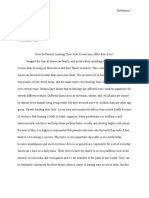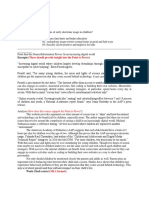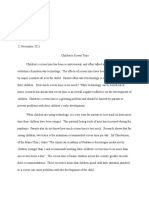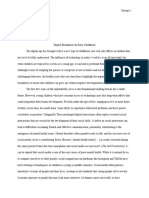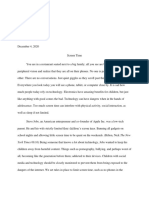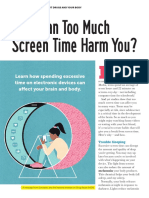1
ScreenTime:ShouldTherebeParentalLimits?
JacobPonds
Lake-SumterStateCollege
ENC1101
JacklynPierce
September28,2021
� 2
ScreenTime:ShouldTherebeParentalLimits?
SincetheintroductionoftheiPhoneinlateJuneof2007,thenumberofhourskidsand
adultsalikehavespentinfrontofscreensandmonitorshasgrownexponentially.Oneisfortunate
toattendanyfunctionandfindsomeonewhodoesnotuse/orhaveaccesstosomesortofdevice.
Eventhoughthepublichashadaccesstosuchdevicessincetheearly2000’sitisonlyrecentlythat
studieshavecomeout,describingtheireffectonthehumanbodyandmind.Thisraisesthe
question,knowingthattherearepossibleadverseeffects,shouldparentslimittheamountoftime
thatkidsspendontheirphonesandotherdevices?Someoftheeffects,asillustratedbyrecent
studies,maybethatscreentimestimulateschildren’sbrainsandeyes,preventingthemfromgetting
agoodnight’ssleep.Anothercouldbethatextendedamountsoftimeinfrontofscreensseemto
haveacorrelationtodepressionandanxietyinteensandyoungadults.Whileanothereffectthat
hasbeenobservedisthelackofsocialskills,whichchildrenwhospendalotoftimeinfrontofa
screentendtohave.Forthesereasons,Ibelievethatparentsshouldlimittheirchildren’sscreen
time,forbothphonesandotherdevices.
Tobeginwith,longamountsofscreentimehavehasbeenproventocauseadverseeffects
onchildren’ssleepscheduleandquality.AstudywrittenbyXuF.,statesthatscreentimeandsleep
qualityseemtohaveaninverserelationshipwithoneanother,withlargeramountsofscreentime
normallyresultinginadecreaseinhoursofsleep,aswellasadecreaseinsleepquality(ZuEtal.,
2019).TheworkalsocitedaDepartmentofHealthandHumanServicessurvey,conductedinthe
early2010s2010’s.Thissurveystatedthat“…adolescentswhoreportedmultipleformsofscreen
timeuse(e.g.,smartphonessmartphoneasmartphone,computer,andtelevision)haddecreased
� 3
sleepquantity”(ZuEtAl.,2019).Thestudyalsostatedthatindividualswhogottherecommended
physicalactivity,whichisanywherebetween30minutestoanhouraday,tendtohaveadeeper
andmoreproductivesleep.However,thesurveynotedthatevenifapersonisactiveandhealthy,
overuseofscreenswillstillresultinadecreaseinsleepquality.Thesetrendsillustratethateven
withotherpositiveattributingfactors,excessivescreentimehasbeenproventolowersleepquality
(ZuEtAl.,2019).AccordingtotheAmericanSleepFoundation,“screentimeislinkedtoahostof
insomniasymptomsinteenagers.Bydelayingthereleaseofmelatonin,screentimepushesback
bedtimeandleadstolessrestfulsleep”(Pacheco,2021).Melatoninisthebody’snaturalhormone
thatpreparesittogotosleep.Thestimulationcausedbyscreentimepreventsmelatoninfrombeing
releasedanddelayssleep.Thislackofqualitysleepcanleadtoaseveredecreaseinproductivity
thefollowingday,orevenacoupleofdays.
Additionally,extendedamountsofscreentimehaveshownatendencytolimitaperson’s
sociallifeoutsideoftheirphones.Aresearchpaperpublishedin2021statesthatthemajorityof
childrenspendfarmorethantherecommended2-hourlimitontheirphones.Theresearchshowed
thattheaverageteenspentbetween3to6hoursadayontheirphone.Thestudytheorizedthatan
increasedamountofscreentimeisdirectlyrelatedtoanincreasedamountofsocialanxiety.Social
anxietyisdescribedasafeelingofstressordiscomfortinsocialsituations.Someassociated
conditions,alongwithsocialanxiety,areobsessive-compulsiveobsessivecompulsivedisorderand
post-traumaticstressdisorder(WestEtAl.,2021).Thestudyalsodiscussesthegeneralnumberof
participantswhoseparentslimittheamountoftimetheyareallowedonscreens.Outofthe
participatinggroups,31%ofparticipatingmalesand15%offemaleparticipantsstatedthattheir
parentsplacedsomesortofrestrictionontheirscreentime.Theparticipantswhoreportedthattheir
� 4
parentsrestrictedtheirscreentimemostlyreportedthattheabsenceofscreensforextended
periodsperiodsoftimehasloweredtheiranxietyinpublicsituations.Thisdoesnotmeanthatthis
groupexperiencesnoanxiety,however,theyhavereportedlowerlevelsofanxietywhenitcomes
tosocialsituations.InastudyconductedbytheWinchesterHospital,researchersconcludedthat
“preteenswhospenttimeawayfromscreensbecamebetteratreadinghumanemotionscompared
totheirpeerswhowerenotrestrictedfromscreens,”(WinchesterHospital2021).Thelackof
emotionalopennessinformsofcommunication,suchastext,haslimitedchildrenandteen’s
communicationskillstothepointwheretheyhavetroubledifferentiationsomeofthemostbasic
formsofhumanemotion.Thecombinationofincreasedlevelsofsocialanxietyandlackofability
toreademotionscontributetoaverylimitedsociallife.
Alongwithsocialanxiety,researchershavenotedanincreaseindepressionlevelsin
childrenwhohavetoomuchscreentime.A2018study,publishedintheEmotionjournal,
concludedthat“Adolescentswhospentmoretimeonelectroniccommunicationandscreens(e.g.,
socialmedia,texting,electronicgames,Internet)werelesshappy,lesssatisfiedwiththeirlives,and
hadlowerself-esteem,especiallyamong8th
and10th graders”(TwengeEt.Al.,2018).Thisis
illustratedinfigurethreeofthearticle.Thisfigureshowsthedirectcorrelationbetweenthe
introductionofphonesandthedecreaseingeneralhappiness.ThefirstiPhonewasintroducedin
2007,whichwasalsorecordedastheheightofadolescents’well-being,at2.13for12th graders,
2.08for10th graders,and2.07for8th
graders,onthefigures1-3scale.From2007to2016thelevel
ofwell-beingsignificantlydropped.Droppingto2.03for12th graders,2.03for10th graders,and
around1.97for8th
graders(TwengeEt.Al.,2018).Thisrapiddroponthescaleisattributedtothe
introductionandincreaseinscreentimesince2007,withcasesofself-esteemissues,depression,
� 5
andanxietyissuesbeingontherise. Althoughscreentimeisnotthesolereasonforanindividual’s
depression,itiscertaintyacausethatcanbeavoidedthroughscreentimerestrictions.
Inconclusion,respectedandtestedsciencehasproventhatexcessivescreentimehas
negativeeffectsonthehumanbodyandmind,especiallyinchildren.Excessivescreentimecan
leadtosleepproblemsthatcanbemistakenasinsomnia,aswellasbeingproventocauseincreased
levelsofanxietyrelatedtosocialsituations,leadingtoadecreaseinsocialinteractions.Large
amountsofscreentimehavealsobeenattributedtohigherlevelsofdepressionandanxietyin
childrenandteens.Theseeffectsaffectscouldbemediated,ornegatedaltogetheralltogether,if
parentsweretostepinandplacelimitsonchildren’saccesstoscreens,orotherformsof
stimulatingtechnology.
¶
¶
¶
¶
� 6
¶
¶
¶
¶
¶
¶
References
Pacheco,D.(2021,February5).Howscreentimemaycauseinsomniainteens.Sleep
Foundation.from
https://www.sleepfoundation.org/teens-and-sleep/screen-time-and-insomnia-for-teens.
Screentimemayaffectsocialinteractionskillsinchildren.WinchesterHospital.(n.d.).,from
https://www.winchesterhospital.org/health-library/article?id=907792
Twenge,J.M.,Martin,G.N.,&Campbell,W.K.(2018).Decreasesinpsychologicalwell-beingamong
Americanadolescentsafter2012andlinkstoscreentimeduringtheriseofsmartphonetechnology.
Emotion,18(6),765–780.https://doi.org/10.1037/emo0000403
West,S.,Puszczynski,R.,&Cohn,T.(2021).Exploringrecreationalscreentimeandsocialanxietyin
adolescents.PediatricNursing,47(3),133–.
Xu,F.,Adams,S.K.,Cohen,S.A.,Earp,J.E.,&Greaney,M.L.(2019).Relationshipbetweenphysical
activity,screentime,andsleepquantityandqualityinUSadolescentsAged16−19.International
� 7
JournalofEnvironmentalResearchandPublicHealth,16(9),1524–.
https://doi.org/10.3390/ijerph16091524




